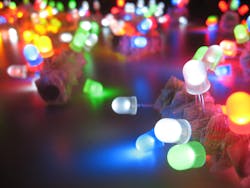Graphene Nanocomposite Dissipates Heat in LED P-N Junction
Scientists in Taiwan found yet another use for graphene as an efficient heat sink between p-n junctions in light-emitting diodes (LEDs). When glued to a polyamide via a titane coupling agent (TCA), reduced graphene improved the thermal conductivity of an interfacial nanocomposite by 53%, compared to a control that contained only the polymer. The study was funded by the Ministry of Science and Technology of Taiwan and published in Carbon (PDF).
âLEDs are semiconductors that emit energy in the form of light when excited by an electric current. Though LEDs do not radiate heat to their outside environment, they generate heat at the p-n junction which can tend to cause fatigue, thermal degradation, and a shorter useful life. Scientists continue to research composites that will dissipate some of the heat at the junction to improve the lifespan of LEDs.
Not only was the graphene nanocomposite 53% more thermally conductive than the polyamide polymer alone, but it came to a higher equilibrium temperature, signifying better heat transfer. When used to coat the interface, LEDs maintained 95% of their light intensity over 7,000 hours, while the control only maintained a mere 68%. The polyamide heat sink also yellowed due to oxidation.
The team elaborates on the benefits of this graphene-polymer composite to include mechanical flexibility to any shape junction, lighter weight, lower cost, and highly efficient heat sink for semiconductor junctions. While creating the nanocomposite turned out to be more costly than manufacturing the polyamide composite, the discovery is actually expected to decrease the cost of LEDs by improving their overall useful life and minimizing the expense of replacements.
Looking for Parts? Go to http://sourceesb.comSourceESB.
About the Author
Leah Scully
Associate Content Producer
Leah Scully is a graduate of The College of New Jersey. She has a BS degree in Biomedical Engineering with a mechanical specialization. Leah is responsible for Machine Design’s news items that cover industry trends, research, and applied science and engineering, along with product galleries. Visit her on Facebook, or view her profile on LinkedIn.

